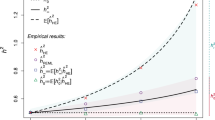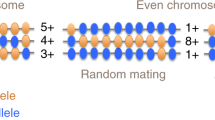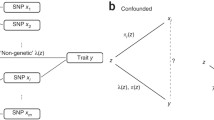Abstract
Spurious associations due to confounding factors are an often cited and intensely debated concern for genetic association studies. Great attention has been focused upon the specific threat of confounding due to population stratification. This emphasis has spurred the development of many statistical genetic methods to detect and correct for the potentially confounding effects of admixture. Unfortunately, this emphasis on admixture has led some authors to suggest that if ethnically homogenous populations are used, spurious associations are unlikely to occur. We show that under small and realistic degrees of assortative mating over time, spurious associations arise even in ethnically homogeneous populations. We demonstrate that structured association and genomic control tests can, under certain conditions, correct for these spurious associations. We conclude that investigators should not assume spurious associations will not occur in association studies using ethnically homogenous populations and recommend the use of genomic control methods and/or family-based association tests within genetic association studies.


Similar content being viewed by others
References
Adams G. T., Snieder H., McKie V. C., Clair B., Brambilla D., Adams R. J., Kutlar A. (2003). Genetic risk factors for cerebrovascular disease in children with sickle cell disease: design of a case–control association study and genomewide screen. BMC Med. Genet. 4:6
Ahern F. M., Johnson R. C., Wilson J. R., McClearn G. E., Vandenberg S. G. (1982). Family resemblances in personality. Behav. Genet. 12:261–280
Allison D. B. (1997). Transmission–disequilibrium tests for quantitative traits. Am. J. Hum. Genet. 60:676–690
Allison D. B., Neale M. C. (2001). Joint tests of linkage and association for quantitative traits. Theor. Popul. Biol. 60:239–251
Allison D. B., Neale M. C., Kezis M. I., Alfonso V. C., Heshka S., Heymsfield S. B. (1996). Assortative mating for relative weight: genetic implications. Behav. Genet. 26:103–111
Ardlie K. G., Lunetta K. L., Seielstad M. (2002). Testing for population subdivision and association in four case–control studies. Am. J. Hum. Genet. 71:304–311
Cardon L. R., Palmer L. J. (2003). Population stratification and spurious allelic association. Lancet 361:598–604
Deng H. W. (2001). Population admixture may appear to mask, change or reverse genetic effects of genes underlying complex traits. Genetics 159:1319–1323
Devlin B., Roeder K. (1999). Genomic control for association studies. Biometrics 55:155–166
Dufouil C., Alperovitch A. (2000). Couple similarities for cognitive functions and psychological health. J. Clin. Epidemiol. 53:589–593
Ewens W. J., Spielman R. S. (1995). The transmission/disequilibrium test: history, subdivision, and admixture. Am. J. Hum. Genet. 57:455–464
Friedlander Y., Kark J. D., Stein Y. (1998). Family resemblance for serum uric acid in a Jerusalem sample of families. Hum. Genet. 79:58–63
Freedman M. L., Reich D., Penney K. L., McDonald G. L., Mignault A. A., Patterson N., Gabriel S. B., Topol E. J., Smoller J. W., Pato C. N., Pato M. T., Petryshen T. L., Kolonel L. N., Lander E. S., Sklar P., Henderson B., Hirschhorn J. N., Altshuler D. (2004). Assessing the impact of population stratification on genetic association studies. Nat. Genet. 36:388–393
Garn S., Sullivan T. V., Hawthorne V. M. (1989). The education of one spouse and the fatness of the other spouse. Am. J. Hum. Biol. 1: 233–238
Hoggart C. J., Parra E. J., Shriver M. D., Bonilla C., Kittles R. A., Clayton D. G., McKeigue P. M. (2003). Control of confounding of genetic association in stratified populations. Am. J. Hum. Genet. 72:1492–1504
Hunt S. C., Dadone M. M., Williams R. R., Wu L. L., Smith J. B., Kuida H., Ash K. O. (1987). Familial correlations from genes and shared environment for urine, plasma, and intraerythrocytic sodium. Am. J. Med. Genet. 27: 249–255
Lynch M., Walsh B. (1998). Genetics and Analysis of Quantitative Traits. Vol 1, Sinauer Associates, INC, Sunderland, MA
Morton N. E., Collins A. (1998). Tests and estimates of allelic association in complex inheritance. Proc. Natl. Acad. Sci. USA 95:11389–11393
Nadeau J. H., Frankel W. N. (2000). The roads from phenotypic variation to gene discovery: mutagenesis versus QTLs. Nat. Genet. 25:381–384
Pérusse L., Bouchard C. (1994). Genetics of energy intake and food preferences. In: Bouchard C. (ed) The Genetics of Obesity. CRC Press, Boca Raton, pp. 125–134
Pritchard J. K., Rosenberg N. A. (1999). Use of unlinked genetic markers to detect population stratificaton in association studies. Am. J. Hum. Genet. 65:220–228
Pritchard J. K., Stephens M., Rosenberg N. A., Donnelley P. (2001). Association mapping in structured populations. Am. J. Hum. Genet. 67:170–181
Risch N., Merikangas K. (1996). The future of genetic studies of complex human diseases. Science 273:1516–1517
Satten G. A., Flanders W. D., Yang Q. (2001). Accounting for unmeasured population substructure in case control studies of genetic association studies using a novel latent-class structure. Am. J. Hum. Genet. 68:466–477
Speers M. A., Kasl S. V., Freeman D. H. Jr., Ostfeld A. M. (1986). Blood pressure concordance between spouses. Am. J. Epidemiol. 123:818–829
Spielman R. S., McGinnis R. E., Ewens W. J. (1993). Transmission test for linkage disequilibrium: the insulin gene region and insulin-dependent diabetes mellitus (IDDM). Am. J. Hum. Genet. 52:506–516
Thomas D. C., Witte J. S. (2002). Point: population Stratification – a problem for case–control studies of candidate–gene associations? Cancer Epidemiol. Biomarkers Prev. 11:505–512
Wacholder S., Rothman N., Caporaso N. (2002). Counterpoint: bias from population stratification is not a major threat to the validity of conclusions from epidemiological studies of common polymorphisms and cancer. Cancer Epidemiol. Biomarkers Prev. 11:513–520
Whittaker J. C., Morris A. P. (2001). Family-based tests of association and/or linkage. Ann. Hum. Genet. 65:407–419
Zhao H. (2000). Family-based association studies. Stat. Methods Med. Res. 9:563–587
ACKNOWLEDGMENT
Supported in part by NIH Grants: K25DK062817, R01DK056366, R01ES009912, U54CA100949.
Author information
Authors and Affiliations
Corresponding author
Rights and permissions
About this article
Cite this article
Redden, D.T., Allison, D.B. The Effect of Assortative Mating upon Genetic Association Studies: Spurious Associations and Population Substructure in the Absence of Admixture. Behav Genet 36, 678–686 (2006). https://doi.org/10.1007/s10519-006-9060-0
Received:
Accepted:
Published:
Issue Date:
DOI: https://doi.org/10.1007/s10519-006-9060-0




